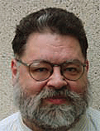
1. First off, tell us more about yourself and what you do!
As a VERY long-time fan, going back to the early Sixties when Astro Boy was on TV, what I do now is immerse myself in as much anime and manga as I can, with an eye toward understanding why its creators made the decisions they made. Japanese readers/viewers look at the world from a different history and culture as the American fans, and we don’t always see the same things. In recent years I’ve written two books–and am working on a third–to try to bring western fans “up to speed” and explain why they’re seeing what they see.
2. What’s your favorite thing about Japan? Do you have a favorite anime?
Japanese culture goes back two thousand years, and you can still sense that in the modern era. Some traditions still live on, in large ways and in small. The biggest difference for me, and the subject of one of my panels, is that Christianity, which is regarded in the west as the One True Church, is a relatively new arrival in Japan, and not exactly a good fit. Looking at what is familiar to me as something unusual takes some adjusting, but it also makes perfect sense.
As for my favorite anime, there are so any examples, but the one I love above all else, and could watch daily, is a lesser-known Studio Ghibli masterpiece: Yoshifumi Kondo’s adaptation of the Aoi Hiiragi girls manga “Mimi-wo Sumaseba”, shown over here as “Whisper of the Heart.” Kondo was a brilliant director who died much too soon; he was an animator for Ghibli and for earlier Miyazaki projects who managed to find and respect the humanity and individuality of all of his characters–even the minor ones. Plus: “Mimi-wo Sumaseba” celebrates the creative process, and as a writer I have to love that!
3. During your times writing about the culture of anime, how has the culture and the fandom
changed since you started?
There have been two big changes. In the mid-90s and earlier, going back to the mid-80s when VCRs first started bringing anime to America in a big way, the fandom was almost 90 percent male and focused on science fiction, since a lot of anime titles were influenced by the Star Wars saga. That all changed in the mid-90s when “Sailor Moon” showed up on broadcast TV and forever changed the fan demographic. It wasn’t all rocket ships and gunplay anymore; shoujo storytelling had gone mainstream, and at first it was as exotic as a really good bowl of udon: common over there but not easy to find over here. But female fans came running, literally from all around the world; now the fandom is much wider, which brought about exposure to many more kinds of stories, told in many more diverse and innovative styles.
The second shift is more recent, and is still happening–so we don’t know yet how it will end. The revolution in home computing has grown exponentially; those of us who were around in the 80s when the Macintosh arrived have seen home computing power grow from megabytes to gigabytes to terabytes. Even hand-held devices can playback any anime anywhere at any time. Video rentals have come and pretty much gone; the word now is “streaming”. This will have an effect on the production of anime, but we can’t see yet what that will be.
4. Can you tell us more about one of your panels?
In keeping with Halloween, I have a panel I’ve had some success with. “From Twilight to Daybreak” is my survey of vampires in anime/manga. Despite the occurrence of some bloodsucking characters in Japanese legend, manga didn’t do anything with them until 1980, when “Black Jack” creator Osamu Tezuka did a parody of Count Dracula. That opened the door for other artists; but, in the context of a culture that is not Christian-based, Japanese vampires aren’t the sparkly romantics of Stephanie Meyer books. They’re either comedy versions of Hollywood, or monsters who surrendered their humanity through their hunger to cheat death. There have been some fascinating examples reflecting Japan’s very different attitudes on the subject.
5. Finally, what are you most excited for at Anime USA?
Getting back to Washington DC. I haven’t interacted with the fanbase there since 2006, when I was Emcee for the Anime Marathon at the Smithsonian. I’ve been limited to the Midwest, so it’s great to be able to see people–and anime–I usually would not catch. This is my first AUSA and I’m really looking forward to it!





